This is an independent review, but note that it contains affiliate ad links. When you buy via these, we may receive a commission, at no extra cost to you.
Quick verdict
Here are the key things you need to know about Ahrefs vs Moz vs Semrush:
Ahrefs is the most generous tool when it comes to project limits and rank tracking. It also has the best broken backlink building tools and works with the most search engines. However, the amount of data you can access with Ahrefs each month is minimal by comparison to the other two products, and there’s no free trial available for it.
Moz is a more basic tool than either Semrush or Ahrefs. Despite similar pricing, it lacks many of their features and has a much smaller keyword database. However, it does let you audit more pages per month than Semrush and Ahrefs, and can be used for a month entirely free before purchase (Ahrefs doesn’t have a trial at all, and Semrush’s is quite short).
Semrush’s key advantage over Ahrefs and Moz is its generosity when it comes to reporting — you can pull much more data every month using the platform than either of its competitors. It’s also much better for PPC research than either Ahrefs or Moz, and its customer support offering is the most comprehensive of the three products. Buying additional seats for Semrush is expensive, however.
Welcome to our Ahrefs vs Moz vs Semrush comparison! The article is divided into two parts — first you’ll find a table that gives you an ‘at-a-glance’ overview of how key features compare across these three platforms, followed by a deeper dive into each one.
At-a-glance feature breakdown
| Ahrefs | Moz | Semrush | |
| Search engines catered for | 9 (including Google, Bing, Amazon and YouTube) | 3 (Main emphasis on Google but limited data available for Bing and Yahoo) | 1 (Google) |
| Project limits | 5 on entry-level plan, 100 on top-tier one | 3 on entry-level plan, 50 on top-tier one | 5 on entry-level plan, 40 on top-tier one |
| Report limit (entry-level plan) | 500 per month | 150 keyword queries and 5,000 backlink queries per month | 3,000 per day |
| Rank tracking limit | 750 on entry-level plan, 5000 on top-tier one | 300 on entry-level plan, 4500 on top tier one | 500 per month on entry-level plan, 5000 on top-tier one |
| Pages crawled/mo (entry level plan) | 100,000 | 400,000 | 100,000 |
| User accounts | 1 per plan, additional seats must be bought | 1 to 5 depending on plan | 1 per plan, additional seats must be bought |
| Backlink database size | 35 trillion | 40.7 trillion | 43 trillion |
| Keyword database size | 20.4 billion | 1.25 billion | 25.2 billion |
| Traffic estimates | Yes | Yes | No |
| Broken link building tools | Excellent | None available | Adequate |
| Search intent data | No | No | Yes |
| Historical data | Since 2015 | None available | Since 2012 |
| Content marketing tools | Partially available | None available | Excellent |
| Site auditing tool | Good | Adequate | Excellent |
| PPC data | Some available | None provided | Extensive |
| Add-ons | None | None | 35 third-party apps |
| API access | Available only on $999/mo enterprise plan | Additional fees of $250/mo – $10,000/mo apply | Available on $499.95 plan |
| Customer support | Email and live chat | Email only | Email, live chat and phone |
| Pricing (non-enterprise plans) | $99 to $399 per month | $99 to $599 per month | $129.95 to $499.95 per month |
| Discount for paying annually | 16.6% | 20% | 16.6% |
| Free trial | None available | Yes — details here | Yes — details here |
* Unlimited in the cases of domains where you can verify ownership.
Search engine data
The main focus of all three products is Google — most of the data supplied relates to its search results. This is hardly surprising, given that around 92% of all searches online are currently carried out using it (source: Statcounter).
However, some data is provided by all three tools for other search engines. In the case of Ahrefs, you can actually perform keyword research for 8 additional search engines, namely:
- Amazon
- Baidu
- Bing
- Daum
- Naver
- Seznam
- Yahoo
- YouTube
As for Moz, this lets you do some limited rank tracking on Yahoo and Bing in addition to Google. And Semrush lets you track Baidu rankings.
Now, it has to be said that the data provided for these other search engines by all three platforms is more limited than the information they surface for Google.

But since Ahrefs offers considerably more data from other search engines, it takes the win here.
Winner for quantity of search engines supported: Ahrefs
Project limits
All three products let you create ‘projects’ that allow you to keep regular tabs on a domain’s keyword rankings, broken links and technical SEO (and more, depending on which platform you’re using). And quite a lot of key functionality for Ahrefs, Moz or Semrush can only be accessed via projects.
Ahrefs and Semrush’s entry level plans are more generous than Moz when it comes to project limits — they let you work with five projects, while Moz’s plan restricts you to three.
As you go up the pricing ladders, you’ll encounter generous project limits — with Moz and and Ahrefs maxing out at 50 projects on their most expensive (non-enterprise) plans; and Semrush capping them at 40 on its top-tier plan.
However, Ahrefs arguably wins again here because, so long as you can verify ownership of them, it technically lets you work with an unlimited number of domains.
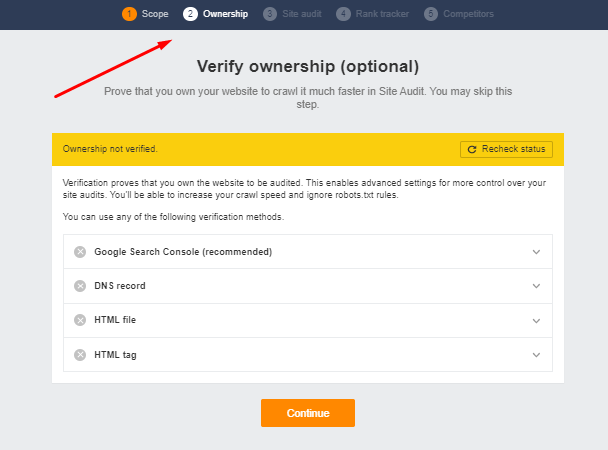
(Verification involves adding some code to your site, adding a DNS record or connecting a Search Console account to Ahrefs).
Tool with most generous project limits: Ahrefs
Reporting limits
When it comes to how many reports you can pull as part of your monthly subscription, it’s a hands down win for Semrush.
Its entry-level plan lets you pull a whopping 3,000 reports per day, while Moz’s equivalent plan lets you run just 150 keyword queries and 5,000 backlink queries per month. And Semrush absolutely trounces Ahrefs here, because Ahrefs caps the number of reports you can pull on its entry level plan at a very meagre 500.
Semrush’s comparative generosity continues as you go up the pricing ladder — if you’re on its top-tier ‘Business’ plan, you get access to 10,000 reports per day, which comfortably beats the reporting caps applied by both Moz and Ahrefs on their equivalent plans (especially Ahrefs’, which only lets you run 750 queries per month on its $399 per month ‘Advanced’ plan).
Tool with most generous reporting limits: Semrush
Rank tracking
Rank tracking — also known as position tracking or SERP tracking — lets you track a website’s daily rankings for a set of target keywords that you define.
Of the three products, Ahrefs’ rank tracker is the most generous. On its entry level plan you can track 750 target keywords, while Semrush’s equivalent plan limits you to 500 and Moz’s 300. It’s a similar situation on more expensive plans — Ahrefs remains the more generous tool when it comes to position tracking.
Not only that, but the position tracking that Ahrefs offers is more ‘granular’ in nature — you can track rankings not just by country (as is the case in Semrush and Moz) but by locality too (town, city etc.).
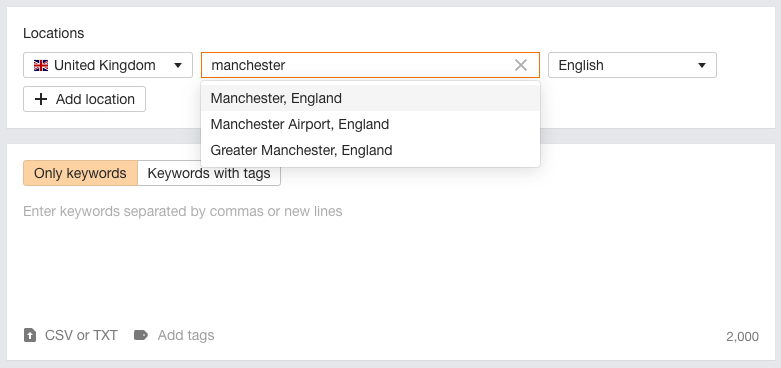
There is a downside to Ahrefs’ position tracking functionality that’s worth flagging up however: by default you are restricted to weekly updates. Getting daily ones involves paying a not-insignificant additional monthly fee (of between $100 and $200 per month, depending on plan).

By contrast, Semrush lets you track rankings on a daily basis by default, and although Moz’s position tracking reports are issued weekly, it also lets you use an ‘on demand’ rank tracker that gives you real-time information on the position of a given keyword in search (this can be used up to 200 times a day).
Finally it’s worth pointing out that (unlike Ahrefs) Semrush and Moz let you track rankings for more search engines than Google. Iin addition to providing data for Google, Semrush caters for Baidu, and Moz’s on demand rank tracker works with Yahoo and Bing.
(This is a slightly surprising situation, because as I discussed above, Ahrefs lets you perform keyword research for a wider variety of search engines.)
So overall, it’s a win here for Ahrefs on quantity and granularity, and a win for Semrush when it comes to daily rank tracking.
Page crawl limits
Every month, all three products crawl any website you’ve added as ‘projects,’ reporting back on any problems it finds with them. Depending on which product you’re using, this could be things like broken links to it; load time; JavaScript errors, traffic etc.
And if you’re working with a large number of domains, or need to analyze very big websites, then the number of pages that can be crawled each month will be particularly important to you.
And it’s here that Moz scores its first victory over Ahrefs and Semrush, because it gives you a much larger monthly crawl limit than both its competitors — on its starter plan, it will happily crawl up to 400,000 pages per month, while Ahrefs and Semrush both restrict you to a 100,000 page crawl.

And as you go up the pricing ladder, it remains the much more generous tool of the three when it comes to page crawl limits.
Tool with most generous page crawl limit: Moz
User accounts
If you need to work in a collaborative way with your SEO platform, something that’s worth paying particular attention to is the issue of user accounts.
Moz is unique among the three tools in bundling multiple seats with its plans, with the number of seats you get on a Moz plan being as follows:
- Standard: 1
- Medium: 2
- Large: 3
- Premium: 5
By contrast with Ahrefs and Semrush, if you want to let more users access your account, there is no choice but to pay for more seats. Semrush charges between $45 and $100 per additional user depending on plan type; Ahrefs deploys quite a confusing approach to seats, where it charges an additional $20 per ‘casual user’ (one that can run 100 reports per month) or $50 per month for a ‘power user’ (one that can run as many reports as the plan permits).
Moz lets you pay for additional users too, should the bundled seat counts not be sufficient for your needs. A flat fee of $49 per user applies, irrespective of plan type.
So overall, the most generous tool when it comes to user account provision is Moz.
Best tool for multiple user access: Moz
Backlink database size
A large chunk of SEO revolves around the number (and quality) of backlinks that point to a website — Google effectively treats backlinks like votes for content, rewarding sites that have a lot of high-quality links pointing to them with higher rankings.
So knowing who’s linking to your competitors is important, because you can target the same or similar sites for backlinks.

According to the three companies’ own published figures, Semrush’s backlink database is the largest: it boasts 43 trillion backlinks to Moz’s 40.7 trillion and Ahrefs’ 35 trillion.
This doesn’t mean that Semrush will always surface the largest number of backlinks, but based on our tests, we’ve found this is usually the case.
Tool with largest backlink database: Semrush
Keyword database size
Your ability to carry out quality keyword research with any of these tools will depend on the number of keywords in their respective databases.
Based on publicly available figures from Ahrefs, Moz and Semrush, their databases contain the following quantities of keywords:
- Ahrefs: 20.4 billion
- Moz: 1.25 billion
- Semrush: 25 billion.
So it’s another win for Semrush here, because its keyword database is the largest of the three.
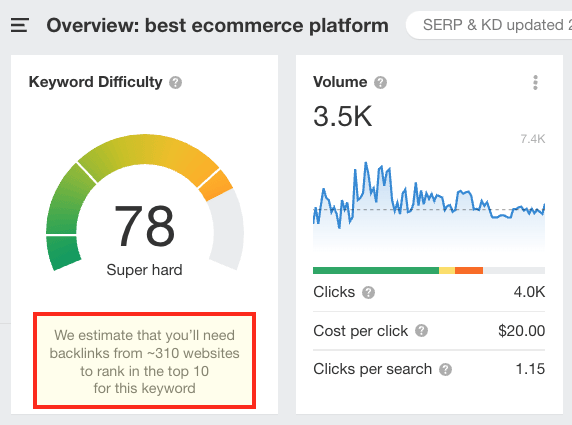
It’s worth drawing attention to the fact that Moz’s keyword database is significantly smaller than the Ahrefs and Semrush equivalents. It’s still huge, and should be fine for a lot of applications — but if you’re working in an area that is ‘ultra-niche’ in nature, you might want to tread carefully before committing to Moz as a keyword research tool.
Of course, quantity is not the same as quality, and all three tools make bold claims about the latter. But if you’re looking strictly at numbers, Semrush wins here.
Tool with largest keyword database: Semrush
Traffic estimates
A key application of SEO tools is using them to get a sense of how many visits a website is getting each month.
The can help you identify which pages on a competing site are driving the most traffic — and reverse-engineer what’s working well. It can also give you ideas for topics to write about in your niche.
Ahrefs and Semrush both beat Moz here, because they offer traffic estimates while Moz doesn’t.
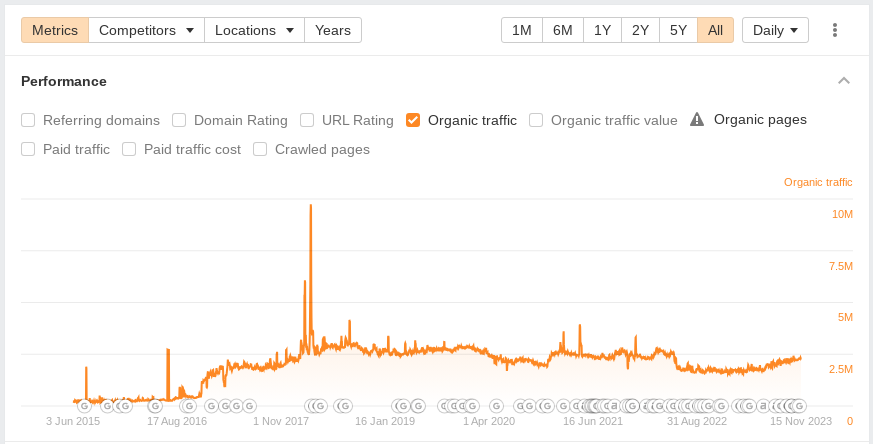
In terms of the accuracy of these estimates, based on my personal experience, I’ve found that Ahrefs’ guesses tend to be more accurate. But it will depend on the sites involved — I’ve noticed that Semrush tends to get it right more often when larger websites are involved.
And to Semrush’s credit, it gives you an idea (via an ‘accuracy indicator’) of how confident it is in the accuracy of its estimates.
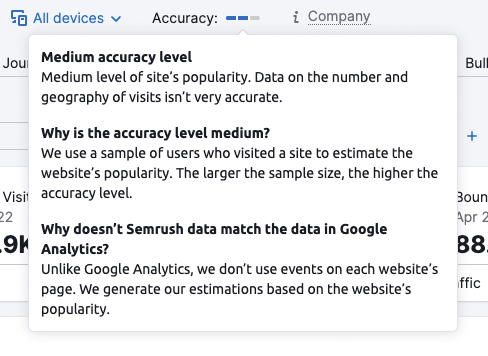
Overall, I’d say that it’s probably a draw here for Ahrefs and Semrush.
Domain authority scores in Ahrefs, Moz and Semrush
Ahrefs, Moz and Semrush assign scores to websites to indicate how much ‘authority’ they have — a ‘Domain Rating,’ ‘Domain Authority’ or ‘Authority Score’ respectively. In all cases, a scale from 0 to 100 is used.

These scores give you an indication of how likely it will be that content published on a given domain will rank highly — or how valuable a backlink from it might be.
The three products’ scores are calculated in different ways however. With Ahrefs and Moz, a domain’s authority score is calculated mainly on the basis of backlinks pointing to it, but Semrush factors in backlinks, site traffic estimates and ‘spam factors’ when calculating it.
(Among other markers, Semrush’s spam factors include an imbalance between links and organic traffic; an unnaturally high percentage of dofollow domains; and too many referring domains with the same IP address).
This theoretically makes the Semrush authority score more accurate than the Ahrefs and Moz equivalents. Interestingly however, the Ahrefs domain rating score is typically used as the industry standard benchmark for evaluating the quality of domains.
Broken backlink building
Broken backlink building is an SEO strategy that involves identifying a link on a site that no longer leads to an active page (i.e., a “broken” one) and then reaching out to its owner, suggesting that they replace it with a link to a relevant page on your own website.
As discussed earlier, Google factors in the number of links to a piece of content, and their quality, when ranking it — and broken link building can be helpful increasing your backlink count.
Of the three tools, Ahrefs is the best option for broken backlink building — it gives you a dedicated (and super easy to use) tool for spotting broken links to a website.

Semrush provides features for identifying broken inbound links too, but they are not quite as easy to use, and Moz doesn’t really provide you with a dedicated broken backlink tool at all.
Best tool for backlink building: Ahrefs
Search intent data
Search intent data gives you more context about why people click on search results for a particular website — to research something, locate a specific page, sign up for something, buy something etc.
And a key thing that differentiates Semrush from Moz and Ahrefs is its inclusion of ‘search intent‘ in the keyword research data it provides.
When you are given a list of keyword suggestions in Semrush, they are accompanied by little letters — I, N, C or T.
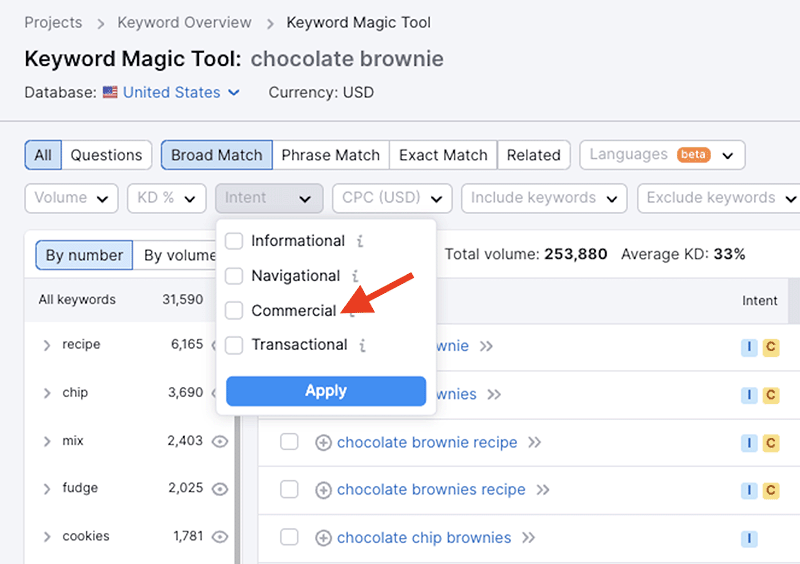
These labels let you know respectively whether a keyword suggestion is informational, navigational, commercial or transactional, with Semrush explaining the terms as follows:
- Informational = user wants to find a specific answer to a question
- Commercial = user wants to investigate brands or services
- Navigational = user wants to find a particular page or website
- Transaction = user wants to complete an action (i.e., a purchase or other conversion).
There is a workaround for establishing keyword intent using Ahrefs or Moz — but it involves a rather clunky process where you ‘infer’ it by looking at the ‘modifiers’ in a search query (words like ‘how’, ‘what’, ‘comparison,’ ‘review’ etc.).
This does get you the data you need — but involves much more time-consuming process than using Semrush.
Best tool for providing search intent data: Semrush
Historical data
Historical data is extremely useful for analyzing long-term trends in website performance and understanding the impact of search engine algorithm updates; it also helps in identifying which SEO strategies have been effective over time and can inform adjustments to future ones.
Of the three products being discussed here, Semrush gives you the most historical data — it’s available from 2012 to the present day, which compares positively with Ahrefs (which covers 2015 to the present day) and extremely positively with Moz (which only gives you access to a few months of historical data).
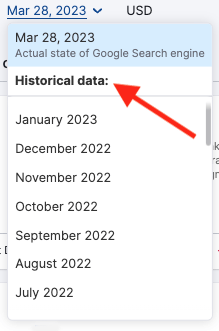
It’s also worth noting that Ahrefs only provides unlimited access to its historical data on its $999 ‘Enterprise’ plan (with its other pricing plans restricting access to between two months and five years of data, depending on the plan involved).
Best tool for accessing historical data with: Semrush
Content marketing tools
SEO is, at the end of the day, all about content — especially so since Google introduced its Helpful Content System (an algorithm that rewards high-quality, ‘people-first’ content). So having some features that help you create high-quality content in your SEO tool can be invaluable.
Semrush gives you a comprehensive set of these — but only if you’re on its $249-per month ‘Guru’ plan or higher. If you are, you can make use of its ‘content marketing platform,’ which gives you access to a topic research tool, content templates, an AI writing assistant and an on-page SEO checker.
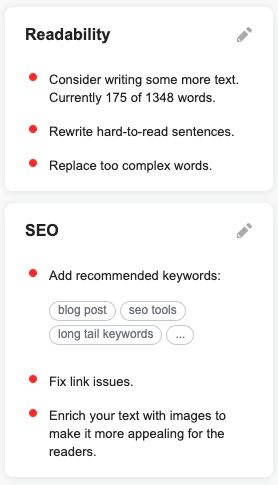
There’s nothing really comparable on offer from either Moz or Ahrefs, but Ahrefs does give you a ‘Content Explorer’ feature that lets you discover and analyze top-performing content in your niche (this can be helpful for generating topic ideas or identifying gaps in your content that you might need to fill).
Tool with best content marketing features: Semrush
During a site audit, SEO tools identify issues that might be having a negative effect on your search rankings. These problems typically include:
- broken links
- slow-loading pages
- duplicate content
- SSL problems
- crawl errors
- missing headers
- overuse of keywords.
You’re then given an overall ‘health score’ along with a report detailing the problems you need to fix.
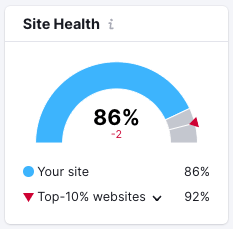
Ahrefs and Semrush both give you similar-quality site audit tools that highlight just about any technical SEO issue you can think of; Moz’s is much less comprehensive, however.
(Examples of issues that Moz’s site crawl won’t necessarily pick up include problems with JavaScript, CSS, alt text and hreflang tags).
Overall though, I’d argue that Semrush’s site audit tool comes out on top. There are a couple of reasons for this: first, it doesn’t just focus on technical SEO, it gives you suggestions on how you can improve your content too.
Second, it lets you send any problem it finds to a CRM tool (its own built in one, Trello or a task manager of your choosing) — this makes it easier to say on top of site health and action any problems in a more structured way.
PPC data
So far in this comparison I’ve looked at features that relate to organic search results. But some users will want to use these platforms to get data on pay-per-click (PPC) results too, or plan entire PPC campaigns with them.
The good news for Semrush and Ahrefs users is that PPC data is provided by both these tools; but unfortunately, none is available from Moz.
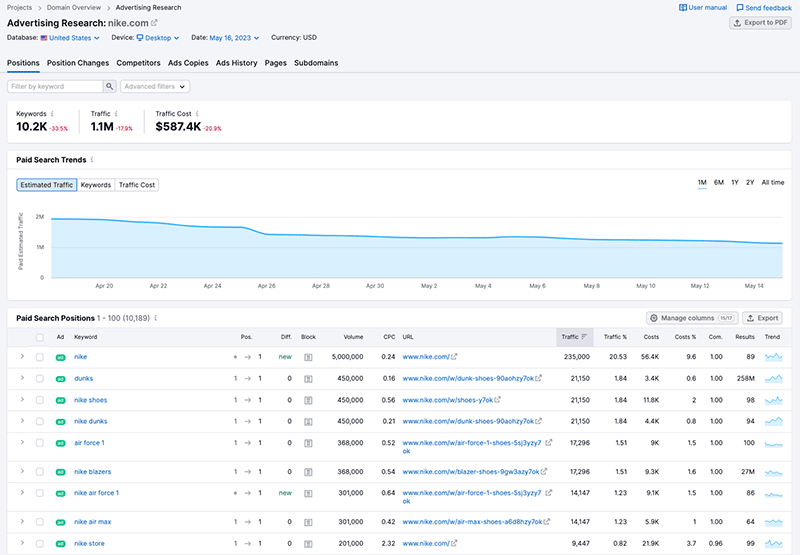
In terms of the quality and quantity of the PPC data provided by Ahrefs and Semrush, it’s fair to say that Semrush wins on both counts. Its dedicated ‘Advertising Research’ section gives you access to a host of PPC advertising metrics for domains, including:
- paid-for keywords
- ad positions
- competitors
- adverts displayed
- ad campaign history
- landing pages
- subdomains used in ad campaigns.
The PPC data supplied by Ahrefs is useful, but more limited — you get to see the ‘paid keywords’ used to advertise a domain, headlines for the ads displayed and the landing pages used in PPC campaigns.
Best option for PPC research: Semrush
Add-ons and integrations
A lot of SaaS (Software as a Service) products like Ahrefs, Moz and Semrush can be integrated with other tools via the installation of apps.
On this front, Semrush has an app store that you can purchase additional functionality or integrations from. At time of writing this contains 35 third-party apps, which have a focus on providing enhanced analytics and data. They typically range in cost from $10 to $150 per month.

Additionally, Semrush offers its own range of add-ons: tools that offer additional market research, content marketing, analytics and local SEO features.
There’s nothing comparable on offer from Ahrefs and Moz however, which require you to make use of their API (more on which in a moment) if you want to create connections with other services.
Best choice for add-ons and integrations: Semrush
API access
An API, or Application Programming Interface, is a piece of software which acts as a bridge that lets different apps communicate with each other. Ahrefs, Semrush and Moz all permit access to their APIs, letting you import SEO data into custom dashboards and reports, or incorporating it into your own applications.
However, this access comes at a price:
- Ahrefs only provides API access on its $999+ ‘Enterprise’ plan (facilitating 2m API calls)
- Semrush only provides it on its $499.95+ ‘Business’ plan (10,000 calls)
- Moz charges additional fees of between $250 and $10,000 per month to use its API (the $250 option gives you 120,000 calls).
Which API option is right for you will depend on what data you need, how many times you need to access the API, and your budget.
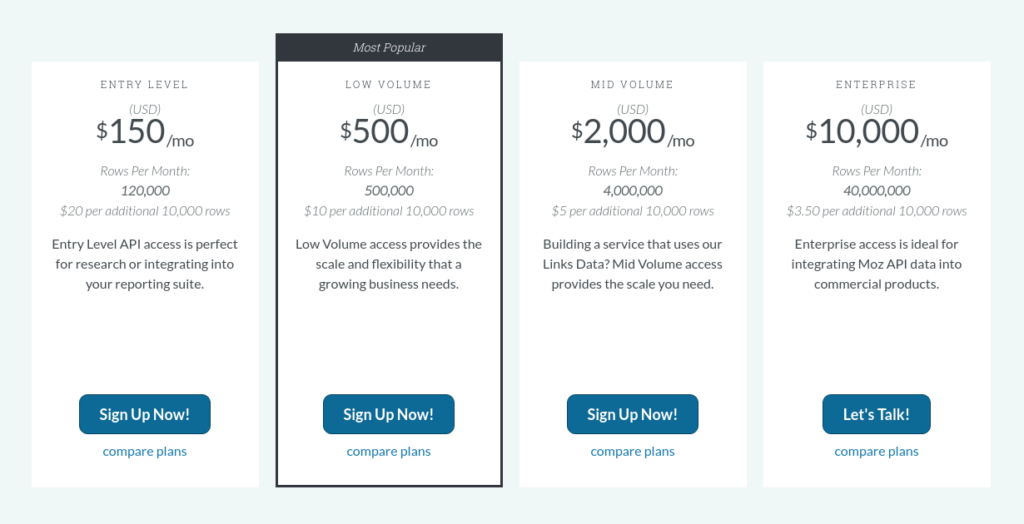
But technically speaking the cheapest API access is provided by Moz.
Customer support
When it comes to support, Semrush offers the most channels, providing customer service via phone, email and live chat.
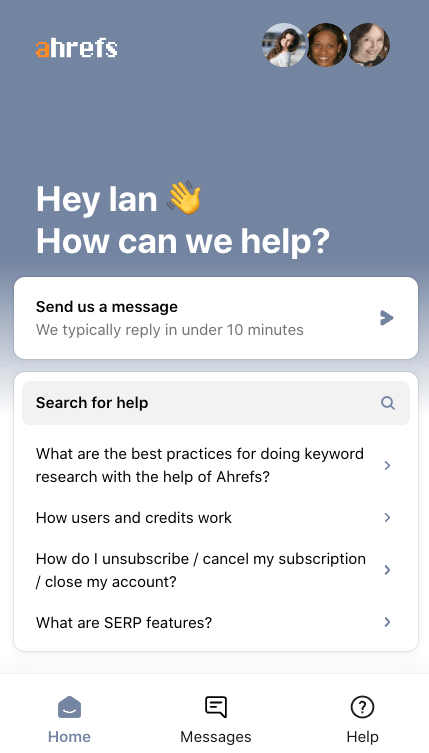
By contrast Ahrefs offers support via email and live chat, and Moz’s support is email-only.
As for online support material, all three platforms provide searchable help portals containing a wide variety of articles and videos. However, Semrush’s is available in multiple languages, while Ahrefs and Moz’s are English only.
Most comprehensive support: Semrush
Pricing and value for money
The three products have similar pricing ranges; all offer non-enterprise plans that range in price from around $99 to $599. The exact pricing structure for each product is outlined below.
Ahrefs pricing plans
- Lite — $99 per month
- Standard — $199 per month
- Advanced — $399 per month
- Enterprise — starting at $999 per month.
Moz pricing plans
- Standard: $99 per month
- Medium: $179 per month
- Large: $299 per month
- Premium: $599 per month
- Moz Enterprise: negotiable
Semrush pricing plans
- Pro: $129.95 per month
- Guru: $249.95 per month
- Business: $499.95 per month
- Custom: negotiable
Value for money
Although the above pricing ranges look fairly similar, it’s really important to note that the functionality you get on each plan varies enormously. In my view, there are a few key areas to zoom in on when trying to establish which product offers the most value for money.
- How much data can be accessed each month
- How many projects can be facilitated
- How many search engines are supported
- How many seats each plan comes with
When it comes to how much data can be accessed, the hands down winner is Semrush — it gives you much more of it. The reporting limits are considerably more generous than those of Ahrefs and Moz (especially so where Ahrefs is concerned). While the Semrush entry-level plan lets you pull 3,000 reports per day, you are limited to just 500 by default on the Ahrefs entry level plan.
As for how many projects can be facilitated, there’s not a huge amount in it, but Semrush and Ahrefs arguably both beat Moz, because their entry level plans facilitate five projects while Moz’s restricts you to three.
And it’s worth highlighting the fact that Ahrefs lets you work with an unlimited number of verified domains (ones you can prove ownership of), giving it a unique selling point in the context of this comparison. However, what you have to watch out for here is the limited number of reports you can pull each month in Ahrefs. It’s all very well being able to work with loads of projects, but if they all share a small reports limit, the value of this option is significantly reduced.
With regard to the number of search engines that are supported, it’s a clear win for Ahrefs. It provides data for nine of them, while Moz and Semrush effectively just cater for one (Google).
As for seats, Moz is probably the best value product here, because unlike Semrush and Ahrefs it bundles multiple seats with plans, and has a simple, flat fee option for adding more. By contrast, Semrush seats get more expensive with plans, and Ahrefs has a rather odd approach to additional seat pricing, involving ‘casual users’ and ‘power users’ that can pull differing numbers of reports each month.
Finally, as is the case with a lot of SaaS (Software as a Service) products, all three solutions give you discounts for paying upfront for a year. In the case of Ahrefs, you get 2 months free (effectively a 16.6% discount) if you do so; Semrush gives you a 16.6% discount too; and Moz is the most generous of the three here, giving you a 20% discount for paying annually.
Free trial availability
Given that the monthly fees for Ahrefs, Moz and Semrush are considerable, you’re probably wondering if there’s a free trial available for them.
In the case of Moz and Semrush, the answer is yes; but unfortunately, Ahrefs doesn’t provide one.
In terms of trial length, Moz’s trial is more generous than Semrush’s, lasting 30 days, while Semrush’s lasts just seven. However, Semrush occasionally makes longer trials available — there’s a double-length one available for a limited time here.
Conclusion
I hope you’ve enjoyed this Ahrefs vs Moz vs Semrush shootout! To wrap things up I’d say that ultimately Ahrefs and Semrush are considerably stronger products than Moz, and worthy of more serious consideration as your SEO tool.
There is a lot to like about Moz, and if it was priced more keenly than Semrush and Ahrefs, there would be an argument for using it instead of them — but the reality is that it offers a lot less functionality and data than these competitors at a very similar price point.
When deciding between Ahrefs and Semrush I’d focus on two things: how much data you need each month, and how many search engines you need data for.
If you think you’re going to be pulling a lot of SEO reports, then Semrush is definitely the better bet — its reporting limits are much more generous than Ahrefs’. But if you need access to search data from a wider range of search engines — including big hitters like Amazon and YouTube, then there’s a lot to be said for investigating Ahrefs.
Now…over to you!
If you have any thoughts or queries about Ahrefs vs Mos vs Semrush, please do leave them in the comments section below.
More Style Factory resources about Ahrefs vs Moz vs Semrush
Fuente: stylefactoryproductions
Hashtags: #Ahrefs #Moz #Semrush

Comentarios recientes